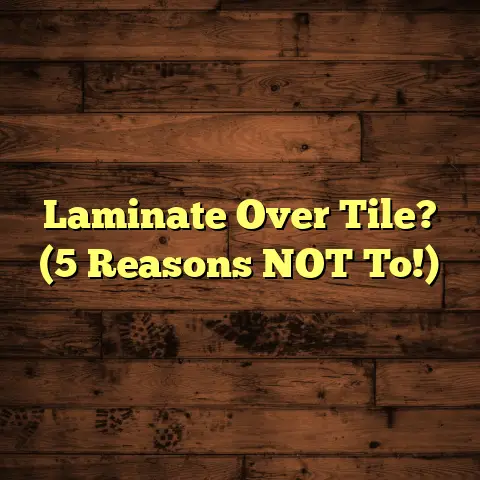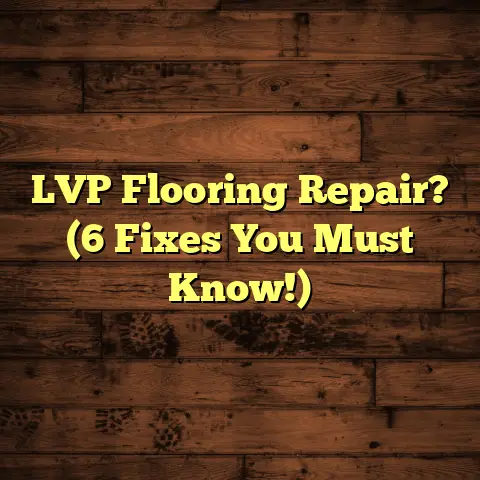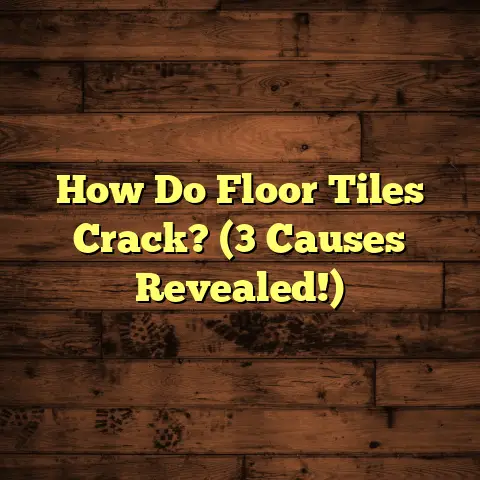Why Does My Floor Make Noise? (1 Reason: Fix Now!)
I’m a flooring contractor, and I know how much we all value our homes.
Flooring is a HUGE part of that,
right?
It’s not just about looks;
it’s about comfort, style, and
that feeling of “home.”
A beautiful floor can really transform a space and, let’s be honest, represents a significant investment.
But what happens when that beautiful floor starts talking back… and not in a good way?
I’m talking about those annoying squeaks, creaks, pops, and bangs! Sound familiar?
These noises aren’t just irritating; they can be a sign of underlying problems.
And trust me, ignoring them won’t make them go away.
In fact, they’ll probably get worse.
Now, before we dive in, let’s talk about some flooring options that are known for being a bit more low-maintenance.
I’m talking about laminate, vinyl, and engineered wood.
These materials are designed to withstand a lot of wear and tear while needing minimal upkeep.
They’ve become super popular because they’re often more affordable and easier to install than traditional hardwood.
But even these resilient options can sometimes fall victim to the dreaded floor noise.
So, what’s the deal?
Why is your floor suddenly sounding like a haunted house?
Well, stick with me, and I’ll walk you through it.
We’ll explore the different types of noises, what causes them, and, most importantly, how to fix them.
Let’s get started!
Section 1: Understanding the Noise
Okay, so your floor is making noise.
But what kind of noise are we talking about?
Is it a high-pitched squeak?
A deep, resonant creak?
A sharp, sudden pop?
Or maybe even a loud, unsettling bang?
The type of noise can tell you a lot about what’s going on underneath your feet.
Let’s break down some common offenders:
Squeaking: This is often caused by two surfaces rubbing together.
Think of it like nails rubbing against wood or wood against wood.Creaking: Creaking is usually a deeper, more drawn-out sound.
It often indicates movement or stress within the subfloor or framing.-
Popping: This can be caused by sudden shifts or adjustments in the flooring material, especially when dealing with floating floors like laminate or engineered wood.
Banging: A banging sound is usually more serious.
It could indicate loose supports or significant movement in the subfloor.
Now, let’s talk about where these noises are coming from.
The source of the noise can be one of several things:
The Flooring Itself: Different types of flooring are more prone to certain noises.
For example, hardwood is more likely to squeak than vinyl.The Subfloor: The subfloor is the foundation upon which your flooring sits.
If it’s uneven, damaged, or not properly secured, it can cause all sorts of noise issues.The Underlayment: Underlayment is a layer of material installed between the subfloor and the flooring.
It provides cushioning, insulation, and moisture protection.
If it’s worn out or improperly installed, it can contribute to noise.Environmental Factors: Believe it or not, things like humidity and temperature can play a big role in floor noise.
Wood expands and contracts with changes in humidity, which can cause friction and movement, leading to squeaks and creaks.
According to the Forest Products Laboratory, wood can swell up to 5% in width when going from 6% to 20% moisture content.
Finally, let’s consider the frequency of the noise.
When does your floor make noise?
Does it only squeak when you walk over a specific spot?
Does it pop every time the temperature changes?
Does it creak all the time, regardless of what’s going on?
The timing of the noise can be a major clue.
For example, a floor that only squeaks when walked on probably has a localized issue, like a loose nail or a gap between boards.
A floor that pops during temperature changes is likely experiencing expansion and contraction issues.
By paying attention to the type, source, and frequency of the noise, you can start to narrow down the problem and figure out the best way to fix it.
Section 2: The One Major Reason for Noisy Floors
Alright, let’s get to the heart of the matter.
While there can be several reasons why your floor is making noise, there’s one culprit that’s responsible for a HUGE number of cases: loose floorboards.
Yep, that’s right.
Loose floorboards are the bane of many homeowners’ existence.
They’re the reason for countless squeaks, creaks, and groans that haunt our homes.
So, what’s the deal with loose floorboards?
Well, when floorboards become loose, they lose their solid connection to the subfloor.
This means they can move and flex more than they’re supposed to.
And when they move and flex, they rub against other boards, nails, or even the subfloor itself.
This friction is what creates those annoying noises we all hate.
Now, you might be thinking, “Loose floorboards?
That sounds like a problem for old houses.”
And you’re right, it’s definitely more common in older homes.
But it can also happen in newer constructions if the flooring wasn’t installed properly or if the subfloor wasn’t adequately prepared.
So, what causes floorboards to become loose in the first place?
There are several factors at play:
Natural Settling of the House: Over time, all houses settle.
This settling can cause minor shifts and adjustments in the structure, which can loosen floorboards.Poor Installation Practices: If the flooring wasn’t installed correctly to begin with, it’s more likely to become loose over time.
This could be due to using the wrong type of nails or screws, not properly spacing the boards, or failing to adequately secure them to the subfloor.Material Shrinkage Due to Humidity Changes: As I mentioned earlier, wood expands and contracts with changes in humidity.
This can cause the boards to shrink and pull away from their fasteners, leading to looseness.
According to the U.S.
Department of Agriculture, wood shrinks and swells mostly in the direction perpendicular to the grain.Wear and Tear From Heavy Foot Traffic: Over time, heavy foot traffic can wear down the fasteners holding the floorboards in place.
This is especially true in high-traffic areas like hallways and kitchens.
So, how do you know if you have loose floorboards?
Here are some telltale signs:
Gaps Between Boards: This is one of the most obvious signs of loose floorboards.
If you notice gaps appearing between your floorboards, it’s a good indication that they’re not properly secured.-
Visible Movement When Stepped On: If you can actually see the floorboards move when you step on them, they’re definitely loose.
-
Inconsistent Sounds Across Different Areas of the Flooring: If some areas of your floor are quiet while others are noisy, it suggests that the noisy areas have loose floorboards.
Now, you might be thinking, “Okay, so I have loose floorboards.
Big deal.
It’s just a little noise.”
But trust me, it’s more than just a little noise.
Having noisy, loose floorboards can have a significant impact on your home:
-
Potential Safety Hazards: Loose floorboards can create tripping hazards, especially for young children and the elderly.
Decreased Home Value: Let’s face it, no one wants to buy a house with squeaky, uneven floors.
Loose floorboards can detract from the overall appeal of your home and lower its value.Psychological Effects of Living With Constant Noise: Living with constant noise can be incredibly stressful and disruptive.
It can affect your sleep, your concentration, and your overall sense of well-being.
So, as you can see, addressing loose floorboards is important.
It’s not just about getting rid of the noise; it’s about protecting your home, your safety, and your sanity.
Section 3: Fixing Loose Floorboards
Okay, so you’ve determined that you have loose floorboards.
Now what?
Well, you have two options: you can try to fix them yourself, or you can call in a professional.
Let’s start with the DIY solutions.
If you’re reasonably handy and comfortable with basic tools, you might be able to tackle this project yourself.
Here’s a step-by-step guide to fixing loose floorboards:
1. Gather Your Tools:
You’ll need the following:
- Screwdriver (or drill with screwdriver bits)
- Wood glue
- Finishing nails (or screws)
- Hammer (or drill)
- Wood filler (optional)
- Sandpaper (optional)
- Safety glasses
- Dust mask
2. Safety First:
Before you start any work, put on your safety glasses and dust mask.
You don’t want to get wood dust in your eyes or lungs.
3. Identify the Loose Boards:
Walk around your floor and carefully identify all the loose boards.
Pay attention to where the noise is coming from and look for any gaps or movement.
4. Secure Loose Boards with Nails or Screws:
If the boards are only slightly loose, you might be able to secure them with finishing nails or screws.
- For Hardwood Floors: Use
finishing nails that are long
enough to penetrate the
subfloor.
Drive the nails in at an angle for better grip. - For Laminate or Engineered
Wood Floors: Use screws
specifically designed for these
types of flooring.
Be careful not to overtighten them, as this can damage the flooring.
5. Use Wood Glue for Added Security:
For extra holding power, apply a small amount of wood glue to the underside of the loose board before securing it with nails or screws.
6. Fill Nail Holes (Optional):
If you used nails, you can fill the nail holes with wood filler to create a more seamless look.
Let the wood filler dry completely, then sand it smooth.
7. Clean Up:
Once you’re finished, sweep or vacuum up any wood dust or debris.
Now, let’s talk about when it’s advisable to call a professional.
Sometimes, DIY just isn’t enough.
Here are some scenarios where you should seek professional help:
Extensive Damage: If a large area of your floor is loose or damaged, it’s best to call in a pro.
They have the expertise and equipment to handle more complex repairs.-
Complicated Installations: If your flooring was complicated to install (e.g., intricate patterns or custom designs), you might not want to risk damaging it by attempting DIY repairs.
-
Uncomfortable With DIY Repairs: If you’re not comfortable working with tools or you’re worried about making the problem worse, it’s always best to call a professional.
Finally, let’s talk about preventative measures.
How can you prevent your floorboards from becoming loose in the first place?
Here are some tips:
Regular Maintenance Checks: Inspect your floors regularly for any signs of looseness or damage.
The sooner you catch a problem, the easier it will be to fix.Ensure Proper Humidity Levels in the Home: As I mentioned earlier, humidity changes can cause wood to expand and contract, leading to looseness.
Use a humidifier or dehumidifier to maintain consistent humidity levels in your home.
According to the EPA, humidity levels ideally should be between 30% and 50%.Use Appropriate Underlayments: When installing new flooring, choose an underlayment that’s appropriate for your flooring type and subfloor.
A good underlayment can provide cushioning, insulation, and moisture protection, which can help prevent looseness.
Conclusion
So, there you have it!
Everything you need to know about why your floor is making noise and how to fix it.
Remember, while noisy floors might seem like a minor nuisance, they can indicate larger problems that need attention.
Ignoring them won’t make them go away.
In fact, they’ll likely get worse over time.
So, take action!
Use the information I’ve provided to assess your situation and determine the best course of action.
Whether you choose to tackle the project yourself or call in a professional, fixing those loose floorboards can make a HUGE difference in the comfort and enjoyment of your home.
Imagine a home free from those annoying squeaks and creaks.
A home where you can walk around without feeling like you’re tiptoeing through a minefield.
A home that’s quiet, comfortable, and safe.
That’s the power of addressing noisy floors.
And let’s not forget the satisfaction that comes from maintaining your home and ensuring its longevity.
Taking care of your floors is an investment in your property and your peace of mind.
So, the next time you’re choosing flooring for your home, consider both aesthetics and functionality.
Think about the materials, the installation process, and the long-term maintenance requirements.
By making informed choices, you can create a beautiful and durable floor that will bring you years of enjoyment.





